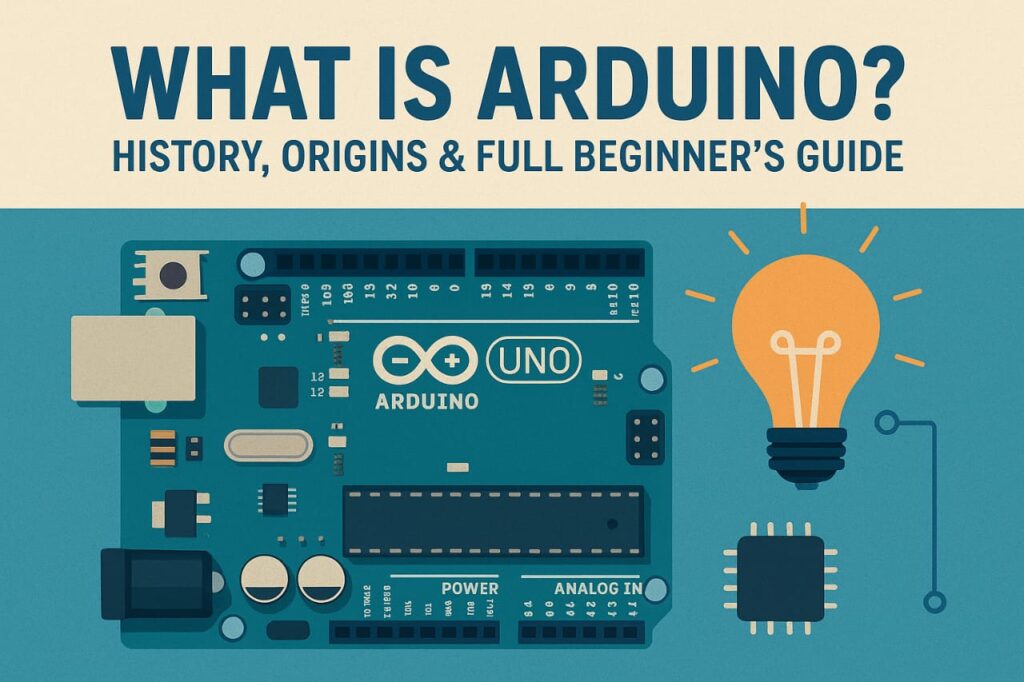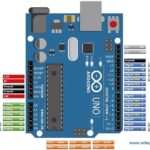What is Arduino? History, Origins & Full Beginner’s Guide
LESSON 1 :What is Arduino?
Arduino is an open-source hardware and software platform, based around easy-to-use microcontrollers and a simplified development environment, that enables hobbyists, designers, students, artists, and engineers to build interactive electronic projects. It consists of:
Hardware: single-board microcontrollers (like the Arduino Uno, Nano, Mega, etc.) with digital and analog I/O pins, often USB connectivity, power and ground pins, etc.
Software: the Arduino IDE and libraries that simplify writing code (in a variant of C/C++) and uploading it to the board.
Open source ethos: both the hardware schematics and the software are made freely available under open source / open hardware licenses, which means others can study, modify, build upon, and even manufacture their own Arduino-compatible boards.
Because of its simplicity, affordability, and wide community support, Arduino has become one of the most popular platforms for physical computing, DIY electronics, Internet of Things (IoT) experiments, prototyping, robotics, art installations, and STEM education.
The Origins: How Arduino Came Into the World
To understand how Arduino became what it is today, we need to go back to its roots: where it started, what problem it tried to solve, who the founders were, and how it evolved over time.
Early Need: Making Electronics & Interactive Design Accessible
Around the early 2000s, interactive design and physical computing (combining programming with sensors, inputs, and outputs) were becoming increasingly interesting to students, artists, designers. However, the tools available were often complex, expensive, or difficult for non-engineers to use.
At the Interaction Design Institute Ivrea (IDII), in Ivrea, Italy, there was a need for tools that design/ art students could use to prototype ideas involving electronics and interaction, without having deep knowledge of microcontrollers or hardware.
Wiring: The Predecessor
Before Arduino, there was a project called Wiring. In 2003, a student named Hernando Barragán developed Wiring for his master’s thesis at IDII. Wiring was a platform that included both a hardware board (PCB with microcontroller) and a software environment, meant to make electronics prototyping more approachable.
Wiring was inspired by Processing, a programming language & environment created to make visual arts easier for beginners, especially non-programmers or designers, to start coding graphics. Processing provided inspiration for Arduino’s IDE and its simplicity.
Birth of Arduino
In 2005, Arduino was born. Massimo Banzi, David Cuartielles, David Mellis, and Gianluca Martino extended Wiring or forked from it, adding support for cheaper microcontrollers (such as the Atmel AVR series) and lowering the cost. They wanted the hardware to be very accessible.
The original Arduino core team is generally considered to be Massimo Banzi, David Cuartielles, David Mellis, Gianluca Martino, plus Tom Igoe.
Why the name “Arduino”?
The name comes from a small bar in Ivrea, Italy. The founders used to meet there. The bar was named “Arduino,” after “Arduino of Ivrea,” a historical figure.
Using the name rooted the project in its local culture. It also made it catchy.
Key Milestones and Evolution
Once Arduino was started, a series of developments helped it become a major platform.
Early Boards and the IDE
The earliest Arduino boards used Atmel AVR microcontrollers — the ATmega8, and later the ATmega168, etc. These were 8-bit MCUs with enough I/O pins to connect sensors, LEDs, buttons, etc. The idea was that you could plug the board into your computer (via USB or serial), write code in the IDE, upload it, and immediately see physical interaction.
The Arduino IDE (based on Wiring / Processing) made programming simpler: it abstracts some of the lower-level microcontroller details so beginners don’t have to worry about setting fuse bits, bootloaders, etc.
Spread and Community Growth
Arduino caught on fast among students, hobbyists, artists. Its low cost, open hardware and software, and good documentation helped. By mid-2011, around 300,000 official Arduino boards had been commercially produced. By 2013, that number had grown to ~700,000.
It also inspired many clones, third-party accessories (“shields”), libraries contributed by the community. Arduino ecosystem became much bigger than just the core team’s work.
Hardware Diversification
Over the years, Arduino released many different board versions for different purposes:
Uno: the common beginner board.
Mega: more I/O pins, larger flash/RAM.
Nano: small, compact form.
Later ARM-based boards (32-bit) for more power and features. IoT-oriented boards, boards with wireless connectivity, etc.
Software / License / Open Source
Arduino’s software (IDE and libraries) is open source (GPL / LGPL etc.). The hardware designs are open hardware (schematics, PCB layouts, etc.). This means people can study and modify everything. Because of open licensing, many clones and compatible boards exist, which helps spread adoption but sometimes leads to issues about quality or compatibility.
Trademark Disputes & Corporate Structure
As Arduino grew, there were disputes around trademark ownership between different groups (Smart Projects, Arduino LLC, etc.). This had some impact on branding and manufacturing. Eventually, Arduino unified under Arduino AG.
What Makes Arduino Unique and Why It Took Off
- Several features and factors combined to make Arduino very popular. Some of the key reasons:
- Affordability: Compared to many microcontrollers or embedded hardware boards, Arduino boards are inexpensive. Students could afford them.
- Simplicity & Ease of Use: The IDE, libraries, easy USB upload, abstraction of hardware complexities, clear documentation — all made it easy for beginners.
- Open Source Hardware & Software: Because both the hardware designs and software are open, anyone can build clones, tweak the design, and contribute. This encouraged a large, active community.
- Strong Community & Ecosystem: Once people started building projects, sharing them, writing libraries, making shields (add-on boards), forums, tutorials — it became easier and more attractive for newcomers. The network effect.
- Designed for Physical Computing: Arduino isn’t just about programming — it’s about sensors, motors, lights, buttons — making it great for interactive, real-world projects. That appeals to artists, designers, hobbyists,
- Flexibility in Hardware: Many versions of Arduino boards for different needs (size, power, I/O, connectivity). Also compatibility with many sensors, modules, community-made add-ons.
- Timeline / Major Versions & Evolution
- Here’s a more detailed timeline of how Arduino evolved over time:
- Year Event / Board / Software Release Significance
2003 Wiring platform created by Hernando Barragán at IDII. Set up the idea of an easier PCB + IDE combo for - 2005 Arduino founded by Banzi, Cuartielles, Mellis, Martino; first Arduino boards built (forking Wiring, adding support for AVR microcontrollers). Birth of Arduino as we know it.
- Mid-2000s Early boards like the Arduino Serial, the original Arduino USB versions etc. Prototypes, refining design.
- 2007-2008 More boards: Arduino Duemilanove, the Mega, etc. The IDE matured.
- 2009-2011 Significant growth in community; estimates of hundreds of thousands of official boards sold. Use in education, hobby projects exploded.
- 2011 onward More specialized boards: wireless connectivity, IoT versions, ARM-based boards, faster MCUs, more I/O, etc.
Applications & Impact
- Arduino has touched many domains. Some of the ways Arduino has influenced technology, education, art, and more:
- Education & STEM Learning: Arduino is used in schools, universities, maker spaces to teach electronics, programming, robotics. Students can immediately build tangible projects which motivate learning.
- Hobbyist / Maker Projects: Many DIY enthusiasts build home automation, weather stations, robots, art installations, wearables using Arduino. Its flexibility and community support make this easy.
- Prototyping: For engineers and designers, Arduino is useful for prototyping hardware, testing sensors, or trying out ideas before committing to custom hardware.
- IoT (Internet of Things): Many Arduino variants now include wireless connectivity (WiFi, Bluetooth, etc.), enabling smart devices and IoT applications.
- Art & Interactive Installations: Because Arduino allows you to bridge software, sensors, and actuators, many artists use Arduino in interactive light installations, sound installations, etc.
- Research & Science Projects: A lot of scientific projects use Arduino boards as inexpensive data acquisition systems, for environmental monitoring etc.
arXiv
Challenges, Limitations & Criticisms
While Arduino has many strengths, it is not without limitations. Understanding these helps use it better, and also shows why sometimes other platforms are used.
Performance / Resource Constraints
Many Arduino boards are 8-bit microcontrollers, with limited RAM, Flash storage, CPU speed. For more complex tasks (high-resolution video, advanced signal processing, machine learning), they may not be sufficient.
Newer ARM-based boards address this, but at higher cost and complexity.
Power, Connectivity, and Hardware Limits
- Some boards have limited power options.
- Wireless connectivity or advanced peripherals add cost and complexity.
- For rugged / industrial / harsh environments, standard Arduino boards may not be durable enough.
- Open Hardware vs Quality / Compatibility
- Because so many clones and third-party variants exist, quality control, compatibility, documentation can vary widely.
- Sometimes outdated or poorly manufactured clones cause frustration.
Scaling / Embedded Deployment
- For mass production of embedded devices, one may need custom hardware rather than off-the-shelf Arduino boards.
- For commercial products, power consumption, cost, reliability, and regulatory approvals may demand different solutions.
Legal / Trademark Matters
The Arduino community has had disputes over trademark ownership, which at times created confusion among users.
Arduino Today & Future
Where Arduino stands now, and what are possible directions for the future.
Current Situation
- Arduino is a large platform with many officially supported boards and many community boards.
- It has defined segments now: Maker, Education, PRO (for professional applications) etc.
- It continues to evolve with new boards supporting more connectivity (BLE, WiFi), low-power modes, IoT integration, cloud tools, etc.
What’s Next
- Better integrations with cloud, IoT, edge computing.
- More powerful MCUs, possibly moving more into hybrid systems (microcontrollers + more powerful processors) for heavier workloads.
- Enhancements in energy efficiency (for battery powered or remote sensors).
- More educational resources, content, kits. Arduino’s mission often emphasizes lowering barriers to entry, so continued improvement in ease of use is expected.
- Perhaps more focus on sustainability, making boards environmentally friendly, or modular.
Conclusion
In summary: Arduino is more than just a microcontroller board. It’s a philosophy, a community, a toolset for enabling people to bring physical ideas to life through electronics and software. It emerged out of a desire to make interactive design accessible, affordable, and fun — especially for people without deep engineering backgrounds. Because of its open-source nature, strong community, ease of use, and constant evolution, Arduino has had an outsized influence on hobbyist electronics, education, prototyping, and the maker movement.
Whether you’re a beginner wanting to blink an LED, an artist seeking to build an interactive sculpture, or a researcher trying to collect data from sensors in the field, Arduino offers a bridge into the physical world, letting you experiment, iterate, learn. Its history shows how innovation can happen when barriers are removed: when costs, complexity, and closed systems are replaced with openness, collaboration, and hands-on learning.
NEXT LESSON 2 Arduino Uno Pinout Explained for Beginners: A Complete Guide with Diagram




Thanks Mahesh for this eye-opening guide on the Arduino platform. You’re doing a great job
please ask content that you need i can try to give you
Hi Mahesh
Intersting History of Arduino
Intersted to connect Arduino UNO to
Robotic Arm and other similar Hardwares
Kindly fwd us full details etc
Thanks
Regards
Khushru Gotla